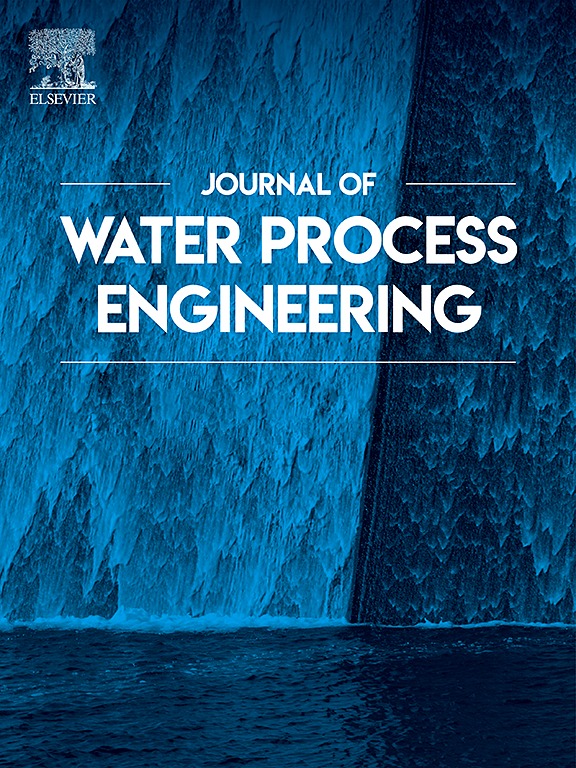Evaluation of various pretreatments of surface water for ion exchange demineralization in industrial applications
IF 6.7
2区 工程技术
Q1 ENGINEERING, CHEMICAL
引用次数: 0
Abstract
This study evaluates pretreatment strategies before ion exchange demineralization for producing high-quality demineralized water from surface water in industrial applications. It focuses on water quality improvements and compares the treatment system's resource efficiencies (water, energy, CO2-equivalent emissions and costs). Four pretreatment methods were examined: (Scenario 0) an existing system using coagulation/flocculation and sandfiltration, (Scenario 1) the addition of a scavenger resin to the existing system to improve organics removal, (Scenario 2) employing biologically activated carbon filtration (BACF) and scavenger resin as a chemical-less alternative, and (Scenario 3) application of BACF with ultrafiltration (UF) barrier. Two of the four scenarios achieve the required water qualities (i.e., TOC ≤ 0.2 mg/L): Scenario 1 and 3. BACF and UF (Scenario 3) showed the best water quality achievements; both technologies complement each other regarding removing organic fractions. Water efficiencies between 93 % (Scenario 2) and 97 % (Scenario 0) can be achieved, where the sludge-water return is crucial, particularly for Scenario 3. CO2-equivalent emissions, combining energy, materials and chemicals used, but also costs, are consistently increased by adding enhanced pretreatments. Specific emissions and estimated costs are slightly lower for Scenario 3 (0.7 kgCO2-eq/m3Prod, 1.4 €/m3Prod) than Scenario 1 (0.8 kgCO2-eq/m3Prod, 1.5 €/m3Prod).

工业应用中各种地表水离子交换脱矿预处理的评价
本研究评估了离子交换脱矿前的预处理策略,以便在工业应用中从地表水中生产高质量的脱矿水。它侧重于改善水质,并比较处理系统的资源效率(水、能源、二氧化碳当量排放和成本)。研究了四种预处理方法:(场景0)使用混凝/絮凝和砂过滤的现有系统,(场景1)在现有系统中添加清除剂树脂以提高有机物的去除,(场景2)使用生物活性炭过滤(BACF)和清除剂树脂作为无化学替代品,以及(场景3)使用BACF与超滤(UF)屏障。四种方案中有两种达到了所要求的水质(即TOC≤0.2 mg/L):方案1和方案3。BACF和UF(场景3)的水质效果最好;两种技术在去除有机馏分方面互为补充。水效率可以达到93%(方案2)到97%(方案0)之间,其中污泥水回流至关重要,特别是对于方案3。通过增加强化预处理,二氧化碳当量的排放量(包括所使用的能源、材料和化学品)以及成本不断增加。方案3的具体排放量和估计成本(0.7千克二氧化碳当量/立方米prod, 1.4欧元/立方米prod)略低于方案1(0.8千克二氧化碳当量/立方米prod, 1.5欧元/立方米prod)。
本文章由计算机程序翻译,如有差异,请以英文原文为准。
求助全文
约1分钟内获得全文
求助全文
来源期刊

Journal of water process engineering
Biochemistry, Genetics and Molecular Biology-Biotechnology
CiteScore
10.70
自引率
8.60%
发文量
846
审稿时长
24 days
期刊介绍:
The Journal of Water Process Engineering aims to publish refereed, high-quality research papers with significant novelty and impact in all areas of the engineering of water and wastewater processing . Papers on advanced and novel treatment processes and technologies are particularly welcome. The Journal considers papers in areas such as nanotechnology and biotechnology applications in water, novel oxidation and separation processes, membrane processes (except those for desalination) , catalytic processes for the removal of water contaminants, sustainable processes, water reuse and recycling, water use and wastewater minimization, integrated/hybrid technology, process modeling of water treatment and novel treatment processes. Submissions on the subject of adsorbents, including standard measurements of adsorption kinetics and equilibrium will only be considered if there is a genuine case for novelty and contribution, for example highly novel, sustainable adsorbents and their use: papers on activated carbon-type materials derived from natural matter, or surfactant-modified clays and related minerals, would not fulfil this criterion. The Journal particularly welcomes contributions involving environmentally, economically and socially sustainable technology for water treatment, including those which are energy-efficient, with minimal or no chemical consumption, and capable of water recycling and reuse that minimizes the direct disposal of wastewater to the aquatic environment. Papers that describe novel ideas for solving issues related to water quality and availability are also welcome, as are those that show the transfer of techniques from other disciplines. The Journal will consider papers dealing with processes for various water matrices including drinking water (except desalination), domestic, urban and industrial wastewaters, in addition to their residues. It is expected that the journal will be of particular relevance to chemical and process engineers working in the field. The Journal welcomes Full Text papers, Short Communications, State-of-the-Art Reviews and Letters to Editors and Case Studies
 求助内容:
求助内容: 应助结果提醒方式:
应助结果提醒方式:


